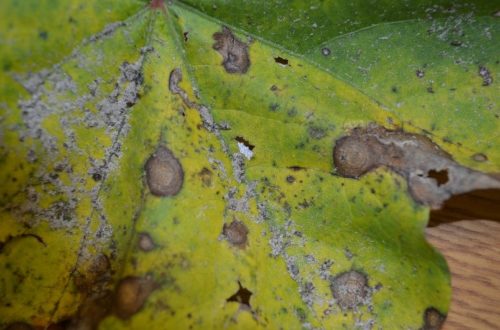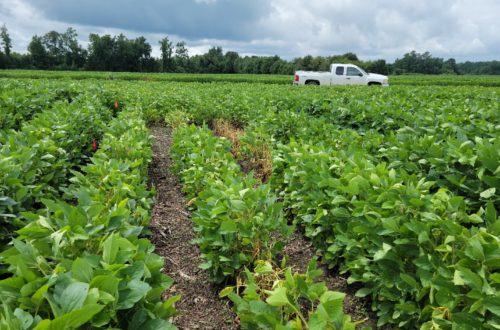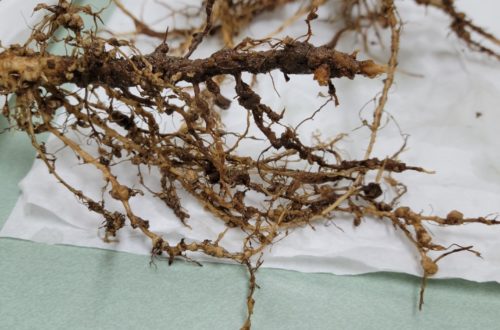In the last two weeks, most of us have received large amounts of rainfall. Daily rainfall of over 2 inches was observed in many areas and several places got 5+ inches of rain in those two weeks. In general, the rainfall was good for crops. However, it also increased our odds of getting foliar diseases on corn, cotton, soybean, and peanut as well as lower stem and root diseases.
Corn
Most corn fields are well into the dent stage moving towards physiological maturity. According to the July 19 SC Crop Progress report our corn is maturing much faster than it did last year, this week about 26% of our corn in the state is mature or at black layer. Depending on the operation this corn will either be field dried or harvested with higher than normal moisture and dried in the coming weeks. With corn this mature we do not recommend spraying a fungicide, this is is basically too late for diseases to cause them much harm. Although it is common in many areas of Georgia, Alabama, and Arkansas, we still have no confirmed cases of Southern rust on corn in South Carolina. We are looking at very good yields in many fields. Our biggest enemy now is the chance of rain & wind that could cause lodging; but nothing we can do about that.
Cotton
Most of the cotton in South Carolina is still looking very clean from a foliar disease standpoint. The high rainfall may have leached out some of our needed nutrients causing nutrient deficiencies which will lead to foliar symptoms of some weak fungal pathogens such as Stemphylium or Aschochyta. These do not pose a great enough risk to yields to warrant spraying. They are reporting Target spot in Georgia which is predictable based on plant growth stage and the excessive rains. We have no reports of Target spot in South Carolina, but it is probably out there and will become more common. Target Spot is a foliar disease that would probably warrant spraying a fungicide on cotton.

Note the diagnostic rings in target spot lesions.
Soybean
The question constantly on the tip of everyone’s tongue is “will we have significant levels of soybean rust this year”, i.e. enough to warrant spraying a fungicide. Soybean rust has been reported in central Georgia, near Vidalia in Toombs approximately 100 miles from the Savannah river. Still not close enough for us to recommend spraying just for rust. If you have soybeans past R-3 with good yield potential, you might want to spray for all of the other foliar and pod and stem diseases based on our wet weather and predicted thunderstorm risk pattern.
Remember rust is only rarely seen prior to flowering in a given field. Croft, Varn, and Mueller have looked at leaves from Barnwell, Bamberg, and Orangeburg Counties but no soybean rust yet in South Carolina.
Jonathan Croft brought us this set of slides from a field in Orangeburg County. The scattered patches of dead and dying plants (Figure 2) is typical of what we will begin seeing now that we are wetter, and plants are starting to grow and mature. Figure 3 shows the primary culprit, root-knot nematode. Figure 4 shows the secondary culprit, the developing red perithecia of Red crown rot which also causes the blackened and rotting root tissue seen in Figure 3. The more rain we get the more likely it is for the dead and dying areas to spread. However, it is too late to spray a fungicide to control this soil borne fungus. Yield losses are usually not as high as they appear to be if you look at a field wide basis.
If you are a peanut grower who rotates with soybean you should take special note if you see any Red Crown Rot in your soybean fields. Red crown rot can be especially damaging to peanut. If you are in this situation you will need to extend your rotation (i.e., treat soybean like it was peanut and rotate out for 2+ yrs) or plan to spray your peanuts with an appropriate fungicide as a preventative spray, early in the growing season before symptoms become evident. Propulse (fluopyram + prothioconazole) or Proline (prothioconazole) in-furrow at-planting are the two most effective fungicides we recommend for protection of peanut against Cylindrocladium Black Rot (same fungus as with Red Crown Rot on soybean, different name on peanut). Soybean is also a host for white mold (southern stem rot), giving us another reason to avoid short rotations between soybean and peanut.
If you are seeing extensive galling on a Southern root-knot nematode resistant variety, you may have Guava root-knot nematode which is very damaging to soybean and cotton and capable of spreading rapidly from field to field. Check with your county row crop agent on how to get a speciation done on your root-knot nematode populations.



